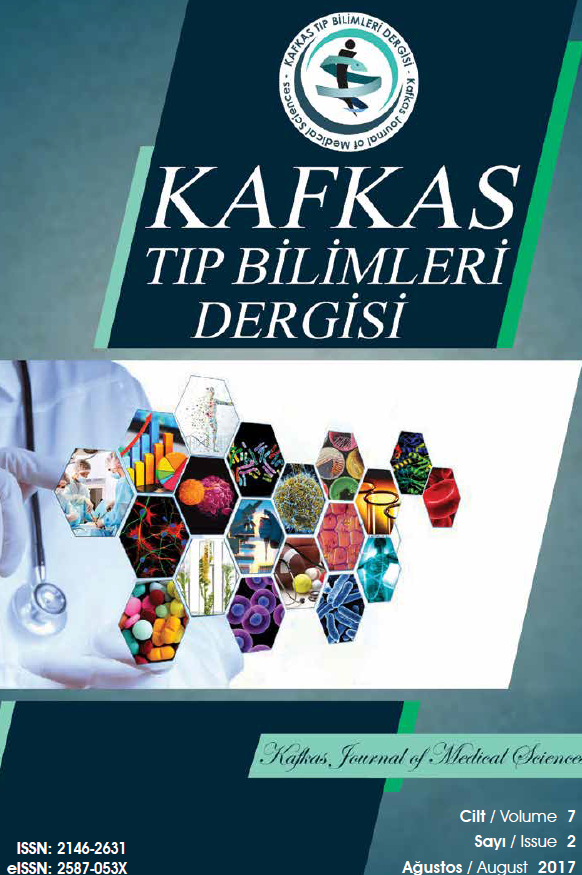Pelvik Organ Prolapsuslu Olgularda Semptomatoloji
pelvik organ prolapsusu; semptomatoloji; vajinal histerektomi
Symptomatology in Cases with Pelvic Organ Prolapse
___
- 1. Jelovsek J, Maher C, Barber MD. Pelvic organ prolapse. Lancet 2007;369:1027–38.
- 2. Swift SE, Pound T, Dias JK. Case-control study of etiologic factors in the development of severe pelvic organ prolapse. Int Urogynecol J Pelvic Floor Dysfunct 2001;12:187–92.
- 3. Gerten KA, Markland AD, Lloyd LK, Richter HE. Prolapse and incontinence surgery in older women. J Urol 2008;179:2111–8.
- 4. Samuelsson EC, Victor FTA, Tibblin G, Svärdsudd KF. Signs of genital prolapse in a Swedish population of women 20 to 59 of age and possible related factors. Am J Obstetrics Gynecol 1999;180:299–305.
- 5. Handa VL, Garret E, Hendrix SDO, Gold E, Robbins J. Progression and remission of pelvic organ prolapse: a longitudinal study of menopausal women. Am J Obstetrics Gynecol 2004;190:27–32.
- 6. Hunskaar S, Burgio K, Clark A. Epidemiology of urinary and fecal incontinence and pelvic organ prolapse. In: Abrams P, Cordozo L, Koury S, Wein A.(Eds). Third international consultation on incontinence, 1st ed. Paris: Health Publication, 2005. p.105–124.
- 7. Swift S, Woodman P, O’Boyle A, Kahn M, Valley M, Bland D et al. Pelvic Organ Support Study (POSST): the distribution, clinical definition, and epidemiologic condition of pelvic organ support defects. Am J Obstet Gynecol 2005;192:795–806.
- 8. Samuelsson EC, Victor FT, Tibblin G, Svärdsudd KF. Signs of genital prolapse in a Swedish population of women 20 to 59 years of age and possible related factors. Am J Obstet Gynecol 1999;180:299–305.
- 9. Swift SE, Tate SB, Nicholas J. Correlation of symptoms with degree of pelvic organ support in a general population of women: what is pelvic organ prolapse? Am J Obstet Gynecol 2003;189:372–7.
- 10. Olsen AL, Smith VJ, Bergstrom JO, Colling JC, Clark AL. Epidemiology of surgically managed pelvic organ prolapse and urinary incontinence. Obstet Gynecol 1997;89:501–6.
- 11. Clark AL, Gregory T, Smith VJ, Edwards R. Epidemiologic evaluation of reoperation for surgically treated pelvic organ prolapse and urinary incontinence. Am J Obstet Gynecol 2003;189:1261–7.
- 12. Ellerkmann RM, Cundiff GW, Melick CF, Nihira MA, Leffler K, Bent AE. Correlation of symptoms with location and severity of pelvic organ prolapse. Am J Obstet Gynecol 2001;185:1332–7. 13. Romanzi LJ. Management of the urethral outlet in patients with severe prolapse. Curr Opin Urol 2002;12:339–44.
- 14. Bai SW, Jeon MJ, Kim JY, Chung KA, Kim SK, Park KH. Relationship between stress urinary incontinence and pelvic organ prolapse. Int Urogynecol J Pelvic Flor Dysfunct 2002;13:256–60.
- 15. Handa VL, Harris TA, Ostergard DR. Protecting the pelvic floor: obstetric management to prevent incontinence and pelvic organ prolapse. Obstet Gynecol 1996;88:470–8.
- 16. Barber M, Walters MB, Bump R. Association of the magnitude of pelvic organ prolapse and presence and severity of symptoms. J Pelvic Med Surg 2003;9:208.
- 17. Kenton K, Shott S, Brubaker L. The anatomic and functional variability of rectoceles in women. Int Urogynecol J Pelvic Floor Dysfunct 1999;10:96–9.
- 18. Meschia M, Buonaguidi A, Pifarotti P, Somigliana E, Spennacchio M, Amicarelli F. Prevalence of anal incontinence in women with symptoms of urinary incontinence and genital prolapse. Obstet Gynecol 2002;100:719–23.
- 19. Handa VL, Harvey L, Cundiff GW, Siddique SA, Kjerulff KH. Sexual function among women with urinary incontinence and pelvic organ prolapse. Am J Obstet Gynecol 2004;191:751–6.
- 20. Rogers RG, Coates KW, Kammerer-Doak D, Khalsa S, Qualls C. A short form of the pelvic organ prolapse/urinary incontinence sexual questionnaire (PISQ-12). Int Urogynecol J Pelvic Floor Dysfunct 2003;14:164–8.
- 21. Ozel B, White T, Urwitz-Lane R, Savas A, Durukan H, Kanik A. The impact of pelvic organ prolapse on sexual function in women with urinary incontinence. Int Urogynecol J Pelvic Floor Dysfunct 2006;17:14–7.
- ISSN: 2146-2631
- Yayın Aralığı: Yılda 3 Sayı
- Başlangıç: 2011
- Yayıncı: Kafkas Üniversitesi
Özgür YILMAZ, Halil Gürsoy PALA, Burcu Artunç ÜLKÜMEN
Platelet Lenfosit Oranı ve Akut Apandisit
Şahin KAHRAMANCA, Gülay ÖZGEHAN, Oskay KAYA, Tevfik Hadi KÜÇÜKPINAR, Hülagü KARGICI, Mehmet Fatih AVŞAR
Yasin TAŞDELEN, Yüksel KIVRAK, Mehmet AŞOĞLU, Rugül KÖSE ÇINAR, Ercan ABAY
İbrahim RENCÜZOĞULLARI, Yavuz KARABAĞ, Metin ÇAĞDAŞ, Süleyman KARAKOYUN, Mahmut YESİN, İnanç ARTAÇ, Doğan İLİŞ, Bahattin BALCI
Adıyaman Üniversitesi Nöroloji Kliniğinde Botulinum Toksin Uygulamaları: Retrospektif Bir Çalışma
Total Diz Artroplastisi Sonrası Hasta Memnuniyetini Etkileyen Preoperatif ve Postoperatif Faktörler
Pınar KÜÇÜK EROĞLU, Yeşim GARİP, Şahap Cenk ALTUN
Pelvik Organ Prolapsuslu Olgularda Semptomatoloji
Yakup BAYKUŞ, Rulin DENİZ, Ebru ÇELİK KAVAK
Küçük Hücreli Dışı Akciğer Kanserinde Anaplastik Lenfoma Kinaz Gen Yeniden Düzenlemelerinin Önemi
Lomber Disk Hernili Hastalarda Perkütan Lazer Disk Dekompresyonunun Etkinliği
Tunika Vajinalis Metastazı ile Prezante Olan Okkult Hepatoid Tip Mide Kanseri: Olgu Sunumu
Yavuz METİN, Nurgül ORHAN METİN, Oğuzhan ÖZDEMİR, Hakkı UZUN, Recep BEDİR
